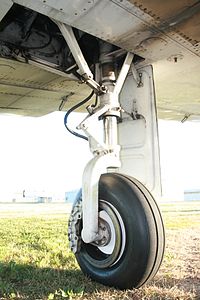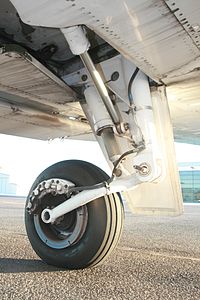An oleo strut is a pneumatic air–oil hydraulic shock absorber used on the landing gear of most large aircraft and many smaller ones.[1] This design cushions the impacts of landing and damps out vertical oscillations.
It is undesirable for an airplane to bounce on landing as it could lead to a loss of control,[2] and the landing gear should not add to this tendency. A steel coil spring stores impact energy from landing and then releases it, while an oleo strut instead absorbs this energy, reducing bounce.[3][4] As the strut compresses, the spring rate increases dramatically because the air is being compressed. The viscosity of the oil damps the rebound movement.[5][6]
- ^ Van Sickle, Neil D.; Welch, John F; Bjork, Lewis; Bjork, Linda (1999). Van Sickle's modern airmanship. McGraw Hill Professional. p. 125. ISBN 978-0-07-069633-4. Retrieved 12 March 2011.
- ^ Welcome Guest Login Here. "Activities, Courses, Seminars & Webinars - ALC_Content - FAA - FAASTeam". FAASafety.gov. Retrieved 26 June 2016.
- ^ "Airframe Structural Design" (PDF). club66pro.com. pp. 456–460. Retrieved 17 June 2020.
- ^ Cite error: The named reference
olson how2019was invoked but never defined (see the help page). - ^ "Flight Training Magazine - AOPA". Flighttraining.aopa.org. November 2004. Retrieved 26 June 2016.
- ^ Fri, 07/22/2011 (26 December 2008). "Oleo struts | Welcome to the P28B Web Site". P28b.com. Retrieved 26 June 2016.
{{cite web}}: CS1 maint: numeric names: authors list (link)

